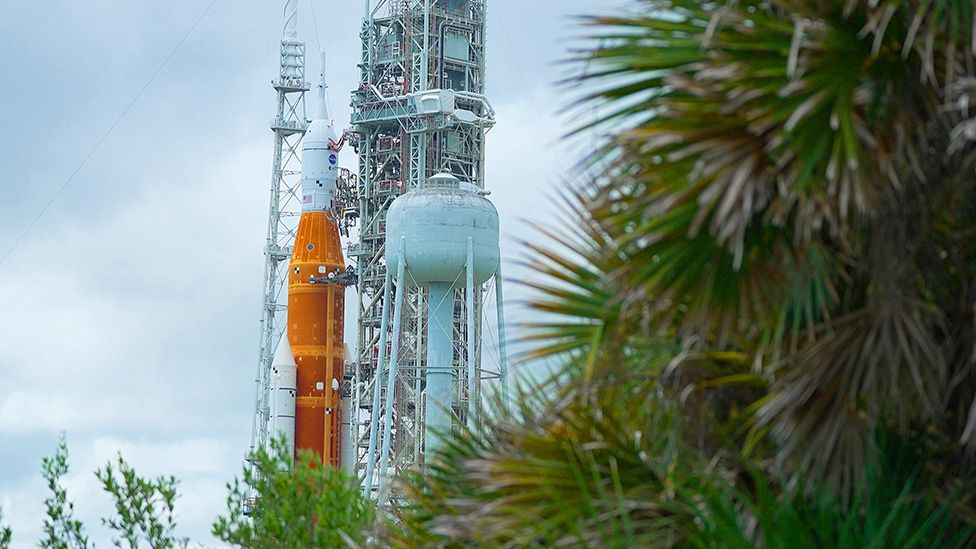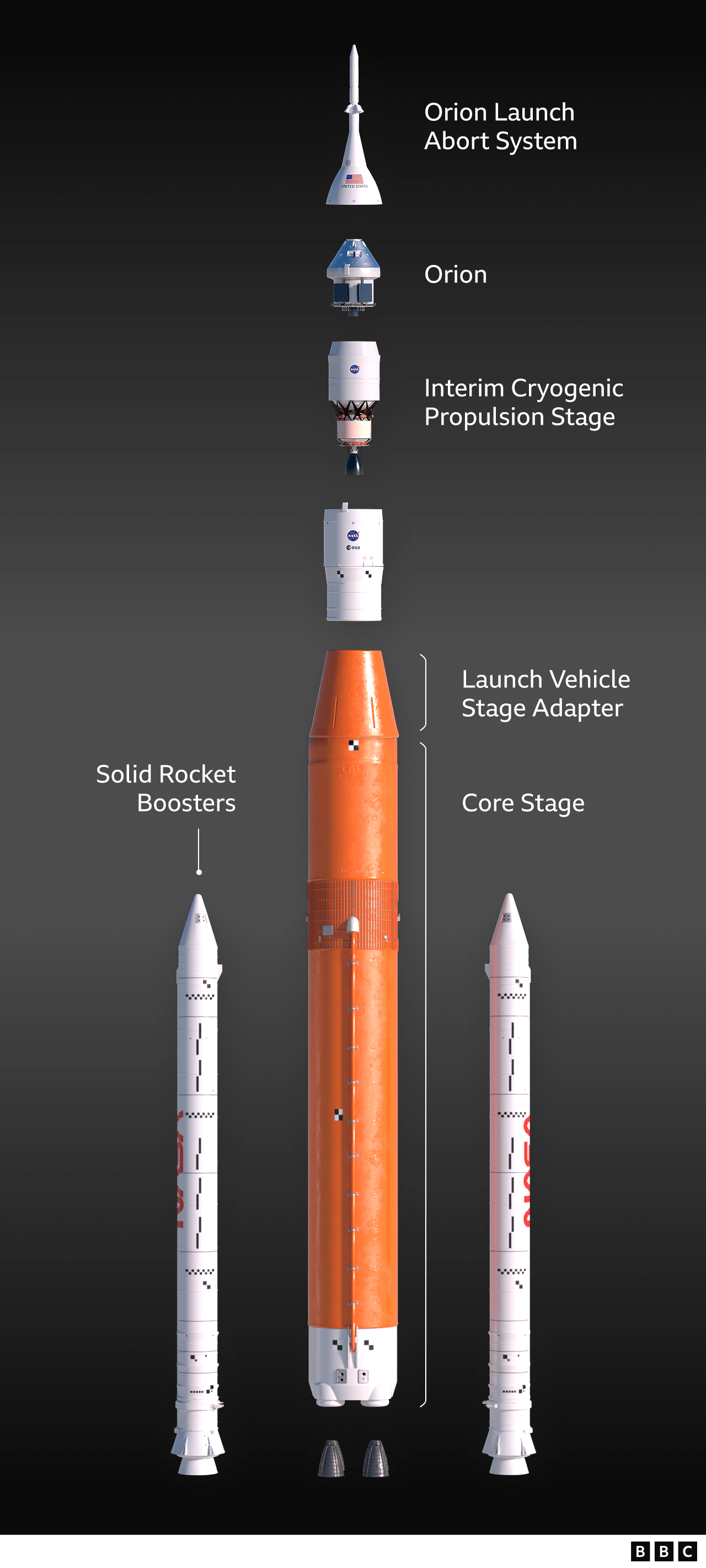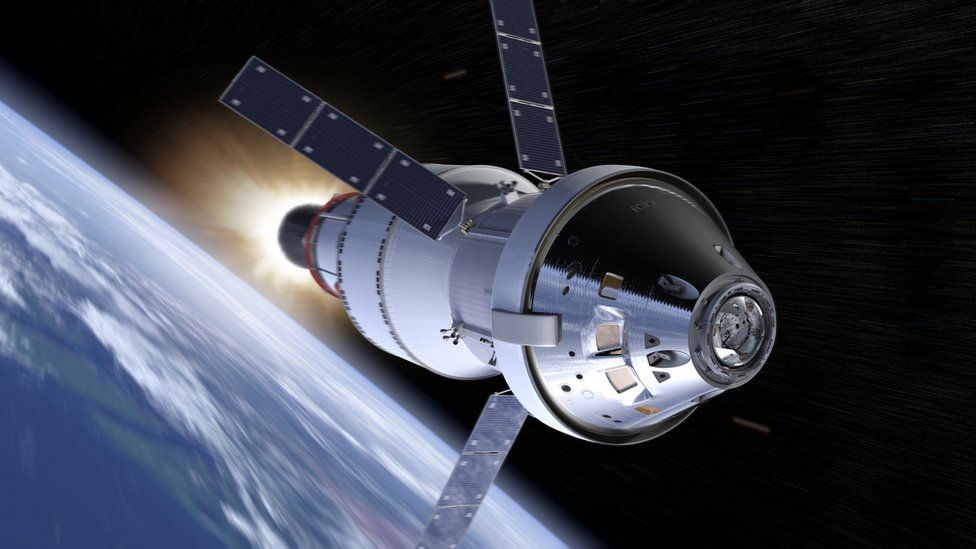After Monday’s scrubbed lift-off bid, the Space Launch System rocket is about to give it another go.

The US space agency will attempt once again in the coming hours to launch its most powerful ever rocket.
Nasa was thwarted by a mix of technical and weather woes when it tried to get the Artemis I Moon mission off Earth on Monday.
But the mood remains positive at Florida’s Kennedy Space Center.
“We’ve got to show up, we’ve got to be ready and we’ve got to see what the day brings,” Mike Sarafin, Nasa’s Artemis mission manager, told reporters.
Saturday’s attempt to despatch the Space Launch System (SLS) rocket has been scheduled for the start of a two-hour window that begins at 14:17 local time (19:17 BST; 18:17 GMT).
The 100m-tall vehicle’s objective will be to hurl a human-rated capsule in the direction of the Moon, something that hasn’t happened since Project Apollo ended in 1972.
Artemis I is a technology demonstration, so there will be no crew aboard on this occasion, but should everything go to plan on the mission then Artemis II, expected to fly in 2024, very definitely will be carrying humans.
Nasa astronaut Jessica Mier said everyone should therefore show some patience as the SLS moves towards its maiden flight, and to not be surprised if there is a further postponement.
“Yeah, of course it’s frustrating for everybody, but it’s not unexpected,” she told BBC News.
“It’s part of how we do things at Nasa. The SLS will eventually have humans on it, my friends, my colleagues. So, we need to make sure this test flight goes well.”

Monday’s bid to fly SLS was ultimately scrubbed because controllers couldn’t be sure the four big engines under the rocket’s core-stage were properly prepared for flight.
The shuttle-era power units are chilled during countdown to -240C to prevent them being shocked by the sudden injection of cryogenic propellants at the moment of launch. But a sensor was indicating that Engine No 3 might be 15-30 degrees short of where its temperature needed to be.
Bill Muddle from manufacturer Aerojet Rocketdyne is confident though that the sensor was faulty, and if it plays up again on Saturday it will likely just be ignored.
“Having reviewed the data and all the other indicators, Engine No 3 could even have been a little bit colder than the others on Monday,” he said.
“We now understand what we need to go look at to get comfortable to go launch.”
This video can not be played
To play this video you need to enable JavaScript in your browser.
If the SLS does get away this time, it is sure to be a spectacular sight.
“It’s gonna be ‘shuttle on steroids’,” said Doug Hurley, who was the pilot on the very last shuttle mission in 2011.
The former astronaut now works for Northrop Grumman who make the big white solid boosters on the sides of the SLS.
“What I always thought was the coolest thing about shuttle launches was you saw it lift off and it was well clear of the tower before you heard anything, and then it was even a little longer before you felt it,” he explained.
“Thrust to weight-wise, SLS is pretty close to what shuttle was. Apollo’s Saturn V rocket was drastically different. I never saw it in person but it lumbered clear of the pad. For shuttle, it seemed like it was clear in an instant, almost as soon as the boosters were lit. SLS should be the same,” he told BBC News.

The first powered phase of the SLS’s ascent will last just over eight minutes.
This will put the upper-stage of the rocket, with the Orion capsule still attached, into a highly elliptical orbit that would see the two of them come crashing back to Earth without any further effort.
So, the upper-stage will have to raise and circularise the orbit before then boosting Orion in the direction of the Moon.
Confirmation that the capsule is on its own, on track and speeding through space at 30,000 km/h (19,000mph) should come two hours and five minutes after launch.
The planned mission length is just under 38 days. This would result in Orion returning to Earth for a splashdown in the ocean off San Diego in California on 11 October.
Thirty-eight days is much longer than the 21 days that capsule manufacturer Lockheed Martin says is the maximum time astronauts should spend in the spacecraft.
But Annette Hasbrook, senior advisor on the Orion programme at Nasa, said engineers wanted to stretch the spacecraft on this mission to understand its limits.

Image source, NASA
“You’re trying to test the edges of your boxes, not your nominal profile,” she explained.